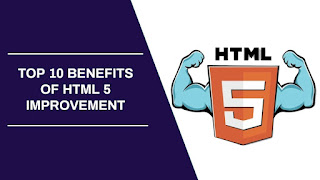Even though HTML5 has been out for about 4 years now, not all web
developers have embraced the new version of the language. Many feel that HTML5
isn’t really worth using yet and that we should wait until it becomes more
stable before developing with it or adding to our existing sites. However,
there are numerous reasons why we should be using this new version of the
language right now instead of waiting to see how things develop in the coming
years. Let’s take a look at 10 of them right now...
1) Offline Storage
Offline storage is one of the coolest features of HTML5. It allows you to store data locally on a user's device without having to worry hire dedicated android app developer about it not being available later if the internet connection is lost. Offline storage is one of the best features because it eliminates many common issues that developers used to have with offline functionality. It also makes apps more reliable and easier to use, as well as being faster and more secure.
2) Semantic Elements
One of the best features in HTML5 is the introduction to semantic
elements. These new tags are a game changer for web design and make it easier
to structure content. The tags are designed to help with screen reader
compatibility, accessibility for disabled users, and improve information retrieval
on websites. The use of these tags has been steadily growing and we can expect
them to continue being used more frequently as designers adopt them.
3) Geolocation API
The Geolocation API is a very useful feature of HTML5. It provides
a device's geographic location to the Web application. The API includes two
interfaces, one interface to get the user's location and another interface to
set the accuracy level for that information. In order to use this API, you need
to include it in your webpage with a script tag and then call it when needed.
4) New Form Elements
Forms are a cornerstone of the web, and HTML5 is making them
better than ever. New form elements such as date pickers, sliders, and color
pickers make it easy for users to input data with just a few clicks. Many
browsers also now have autofill functionality that can remember names,
addresses, credit cards numbers, etc., making data entry faster for returning
visitors and drastically reducing the chances for errors in data entry.
5) Audio and Video Support
HTML5 was built from the ground up to work better on today's
websites and mobile devices. This is why the newest edition has many new
features, one being audio and video support. Not only can you embed audio or
video from a variety of providers, like YouTube and Vimeo, you can also create
your own. You'll find all sorts of amazing features for audio and video in this
latest upgrade!
6) Drag and Drop
Drag and Drop is one of the best features of HTML5. It allows
users to drag items from a list, such as images or text, and drop them into an
appropriate location in the document. Drag and Drop is a very intuitive feature
that will make creating content much easier. One thing to note is that this
feature only works with certain browsers so it may not be available on your
device right now.
Drag and Drop is also compatible with touch devices which makes it
perfect for mobile phones and tablets where it can be difficult to type out
long passages. Plus, Drag and Drop can help reduce file size as you're dragging
images from one place to another rather than copying all the content over which
saves time and space.
7) WebGL Support
WebGL is a JavaScript API that brings hardware-accelerated 3D
graphics to the web. It's an open standard maintained by the Khronos Group and
can be used without any vendor prefixes.
WebGL started as a project at Mozilla, but it's been adopted by
other browsers too. You can check out some WebGL demos on sites like Sketchfab
or even see if your browser supports it with this test page.
8) WebSockets
WebSockets is a protocol that allows for two-way communication
between the browser and server. It uses TCP port 80 by default, but can also be
configured to use other ports. This feature enables web developers to have
faster page loading times and more interactive websites. WebSockets is
supported in all major browsers except Microsoft Edge which only supports it
partially.
9) Microdata
Microdata is an important part of the HTML5 specification. It
enables publishers to provide a more complete description of their content and
make it easier for developers to access and utilize the data. Microdata
increases accessibility, search engine optimization, and overall web
development.
1) Increased Accessibility - The use of microdata can help improve
accessibility for those with disabilities such as blindness or low vision by
providing descriptions for images or videos that are used in the content.
2) Search Engine Optimization - Proper use of microdata can
enhance search engine optimization by improving the website's ability to be
found through search queries on both desktop and mobile devices.
3) Enables Developers - When properly implemented, developers will
find it easier to add enhancements and new features to the site without needing
to change any code.
4) Extra Data Points - As well as adding information about images
and video clips, microdata includes extra data points which allow webmasters to
describe products, recipes or event listings.
5) Standardized Data Structures - Microdata is standardized so
that other websites will know how to interpret the information.
6) Simplified Code Creation-Microdata simplifies code creation for
creating semantic markup because it includes what should be added instead of
requiring programmers write specific instructions on how each element should be
coded individually.
7) Ease of Use-Webmasters can easily use this new feature without
needing extensive knowledge of coding languages like HTML5.
10) Cross Document Messaging
Cross-document messaging, or web messaging, is a standard that
allows you to send messages between windows on the same domain. This can be
done in two ways: postMessage and BroadcastChannel. PostMessage is a one-to-one
communication channel, while BroadcastChannel allows you to broadcast your
message to all other windows on the same domain. To use either of these
standards, you need to attach the following methods onto the target window
object: addEventListener() and removeEventListener().
Conclusion
HTML5 is a huge leap forward hire dedicated ios developers in web technology. It changes the way we think about what a website can do, how it looks and how we interact with it. It provides developers with an amazing range of tools to create an interactive, rich internet experience. It also makes content available to everyone, even those without an internet connection or devices that are unable to access certain parts of the web.




Comments
Post a Comment